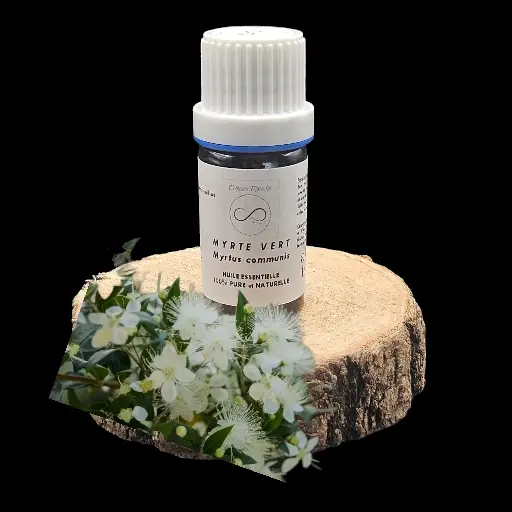Green Myrtle essential oil
Botanical name: Myrtle communis
Distilled part: Rameau
Botanical family: Myrtaceae
Origin: Corsica
Chemical composition:
- Aldehydes: Myrtenal
-- Esters (in trace amounts): Bornyl Acetate, Geranyl Acetate, Linalyl Acetate, Myrtenyl Acetate, Neryl Acetate, Terpenyl Acetate, Trans Carvyl Acetate, Methyl Myrtenate
- Lactones
- Monoterpenes: Alpha Pinene (25%), Beta Pinene
- Monoterpenols: Alpha Terpineol, Geraniol, Linalool, Myrtenol
- Oxides: 1.8 Cineole (45%)
- Sesquiterpenes: Alpha Humulene, Beta Caryophyllene
Legend: * powerful,** very powerful;*** extremely powerful (power value for the associated pathology)
PHYSICAL PROPERTIES AND THERAPEUTIC INDICATIONS
Amenorrhea
Angina (candida-inconstant, klebsiella, staphylococci)
Anti-infectious*
Antispasmodic (mild)
Bronchitis
Catarrh
Deficient eyelashes and eyebrows
colibacillary enteritis
Expectorant*
Ovarian hormone-like
Hypothyroidism*
Hypnotic*
Immunostimulant
Insomnia*
Non-colibacillary urinary tract infection
Cystic fibrosis
Wrinkled skin
Prostate: Decongestant*
Sedative
Sinusitis
Hepato-biliary stimulant
Skin toner
EMOTIONAL, PSYCHIC PROPERTIES AND THERAPEUTIC INDICATIONS:
Anxiolytic (chronic case)
Calming
Anger
Emotional disorders
Concentration (favors)
Dépression
Reference and bibliographic source: Lily BAYER and Dr Hervé STAUB, (2013) “In-depth treatise on Phyto and Aromatherapy”, Ed. Grancher. p. 595.
INDICATIONS IN AROMATHERAPY AND THE USE OF ESSENTIAL OILS DO NOT CONSTITUTE A MEDICAL DIAGNOSIS AND DO NOT REPLACE THE ADVICE OF A DOCTOR OR MEDICAL TREATMENT!





